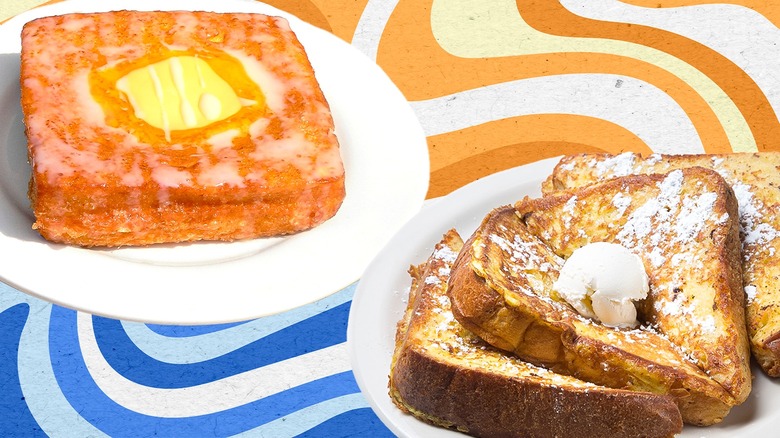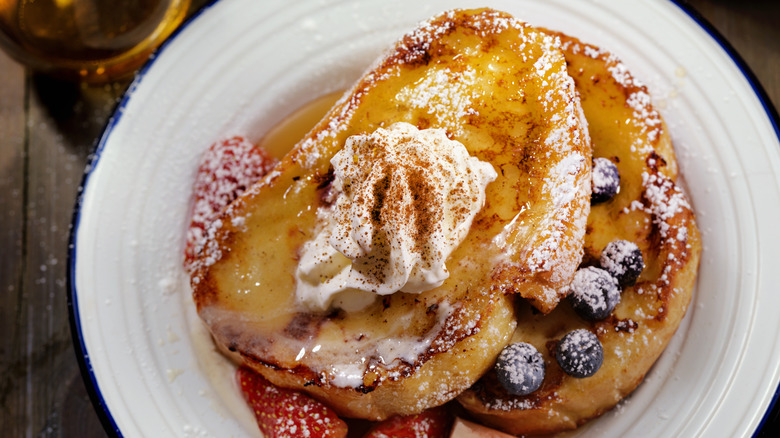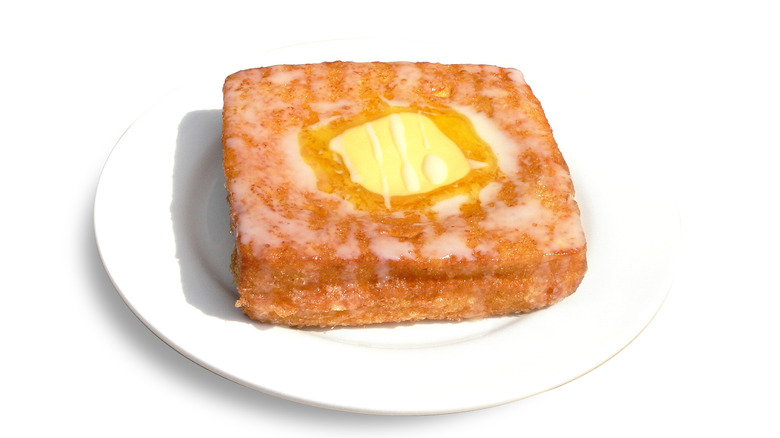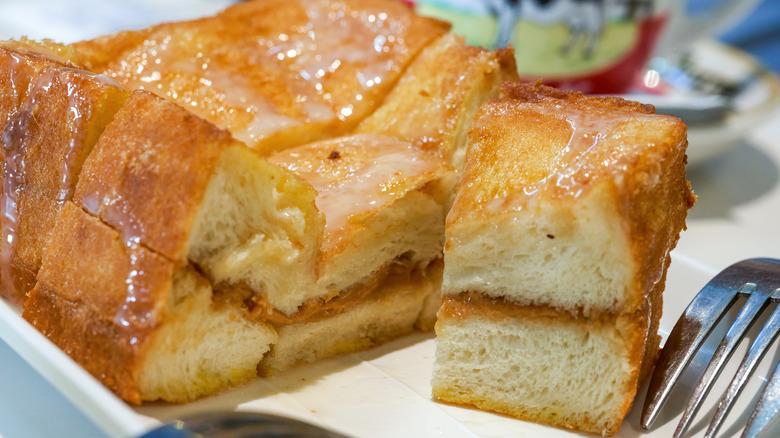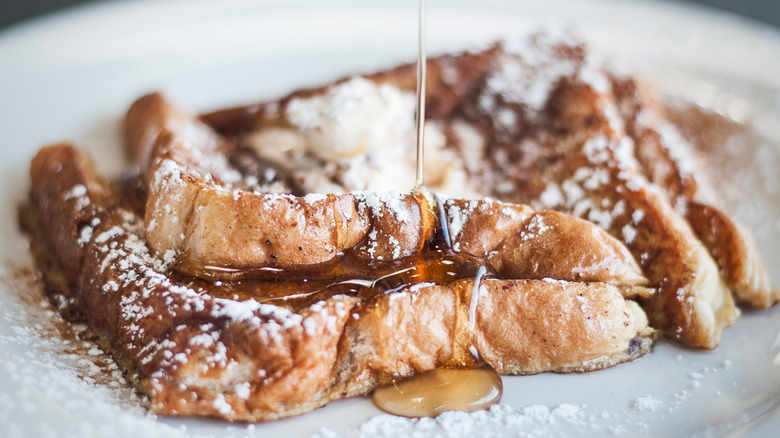French Toast Vs Hong Kong Style: What's The Difference?
French toast and Hong Kong-style French toast, though sharing a name, are culinary cousins with distinct differences. The classic French toast we know and love involves slices of bread soaked in a mixture of eggs, milk, and spices before being pan-fried to golden brown perfection. Hong Kong-style French toast, on the other hand, takes the concept to a whole new level. What sets it apart is the inclusion of a luscious filling, often peanut butter or hazelnut spread, sandwiched between the slices of bread.
While traditional French toast showcases a fluffy, custardy interior with a crisp exterior from pan-frying, Hong Kong-style French toast takes it a step further. It's shallow-fried to create an incredibly crunchy, indulgent shell that encapsulates the delectable, creamy filling. These textural distinctions offer a delightful contrast of crispy, creamy, and utterly satisfying flavors. But to fully understand how these similar dishes came to be and evolved, let's take a deeper look at these two types of French toast.
What is French toast?
French toast is a beloved breakfast dish known for its comforting taste and versatility. Its roots can be traced back to ancient Rome, where it was originally called "Pan Dulcis." This early version consisted of stale bread soaked in a mixture of milk and eggs, then fried in oil or butter. However, French toast's journey didn't stop there.
As time passed, this humble dish made its way through different cultures and regions, each adding its unique touch. In medieval Europe, it was known as "pain perdu" or "lost bread," as it was a clever way to repurpose stale or leftover loaves. By the 17th century, it had become a popular breakfast item in France, and the name "French toast" stuck, despite variations of the dish existing worldwide — including Hong Kong.
The essence of French toast lies in its transformation of simple ingredients into a delightful culinary experience. Slices of bread are soaked in a mixture of beaten eggs, milk, or cream, seasoned with vanilla, cinnamon, or sugar, depending on personal preference. These soaked slices are then pan-fried until golden brown, creating a crispy exterior while maintaining a soft, custardy interior. The crispy, slightly caramelized edges offer a delightful contrast to the tender, egg-infused center, making it a delightful canvas for various toppings like maple syrup, powdered sugar, fresh fruit, or even a dollop of whipped cream.
What is Hong Kong-style French toast?
Hong Kong-style French toast, sometimes referred to as Western toast, is a beloved dish that offers a unique and indulgent flavor experience. Its roots can be traced back to Hong Kong's colonial era when British influence left an indelible mark on the local culinary scene. This dish is a testament to the creative adaptation of Western concepts to suit the local palate.
At its heart, Hong Kong-style French toast consists of two slices of bread filled with a thin layer of peanut butter or hazelnut spread. These slices are then assembled into a sandwich, dipped in a mixture of beaten eggs, and shallow-fried until they acquire a lusciously golden-brown crust. The result is a delightful medley of flavors and textures. The exterior of the toast is incredibly crispy and slightly caramelized, offering a satisfying crunch, while the interior remains creamy and rich, thanks to the sweet fillings. The combination of sweet, nutty, and creamy elements creates an irresistible harmony that satisfies both sweet-tooth cravings and the desire for comfort food.
Hong Kong-style French toast is made with a filling
The distinction between classic French toast and its Hong Kong-style counterpart lies in the preparation and, more notably, the presence of a tantalizing filling. In traditional French toast, individual slices of bread are briefly soaked in a mixture of beaten eggs with milk or cream. This imparts a deliciously smooth texture to the slices when they're pan-fried. However, Hong Kong-style French toast takes this concept to a whole new level. Here, several slices of bread are joined together, often with a thin, flavorful layer of filling such as peanut butter, chocolate, hazelnut spread, or even banana slices, though alternatives like almond butter are equally delectable.
This extra layer of indulgence transforms each bite of Hong Kong-style French toast into a delightful surprise, offering a creamy, nutty contrast to the crispy exterior. The filling infuses the dish with an irresistible sweetness, creating a harmonious blend of textures and flavors that elevate it beyond the ordinary. As the bread is soaked in the egg mixture, it envelops the filling too, ensuring that every mouthful has both a custardy interior and a crunchy exterior.
French toast is pan-fried
Apart from its filling, the key distinction between the two types of French toast lies in the method of cooking, and this difference significantly impacts the resulting texture of the dish. Traditional French toast is pan-fried, which means it's cooked by placing individual slices of soaked bread on a flat griddle or skillet. This cooking method imparts a delectably crispy exterior while maintaining a tender, custard-like interior.
In contrast, Hong Kong-style French toast takes a unique approach by shallow frying the assembled slices. The shallow frying method used for Hong Kong-style French toast results in an exceptionally crispy and slightly caramelized exterior, providing a satisfying contrast to the creamy, melt-in-your-mouth interior created by the filling. This textural contrast is what sets Hong Kong-style French toast apart, making it an irresistible treat that's both crunchy and indulgent.
While both versions of French toast are undeniably delicious, it's this innovative approach to cooking that makes Hong Kong-style French toast an exciting twist on the classic, offering a mouthwatering blend of textures that's sure to delight anyone fortunate enough to savor it. So, the next time you want to shake up your French toast, consider this tantalizing take on the classic dish.
